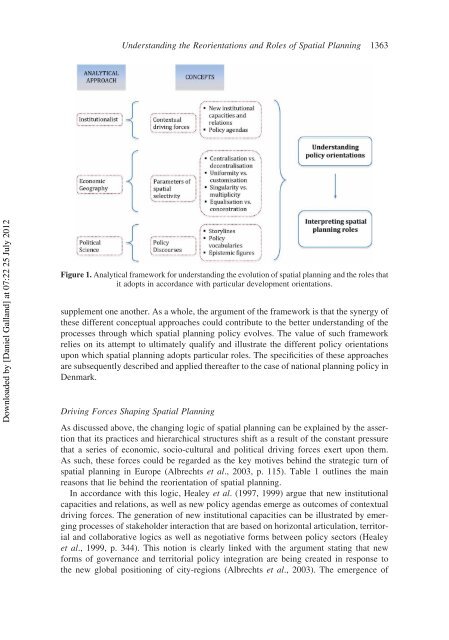Galland EPS 2012 - VBN
Galland EPS 2012 - VBN
Galland EPS 2012 - VBN
You also want an ePaper? Increase the reach of your titles
YUMPU automatically turns print PDFs into web optimized ePapers that Google loves.
Understanding the Reorientations and Roles of Spatial Planning 1363<br />
Downloaded by [Daniel <strong>Galland</strong>] at 07:22 25 July <strong>2012</strong><br />
Figure 1. Analytical framework for understanding the evolution of spatial planning and the roles that<br />
it adopts in accordance with particular development orientations.<br />
supplement one another. As a whole, the argument of the framework is that the synergy of<br />
these different conceptual approaches could contribute to the better understanding of the<br />
processes through which spatial planning policy evolves. The value of such framework<br />
relies on its attempt to ultimately qualify and illustrate the different policy orientations<br />
upon which spatial planning adopts particular roles. The specificities of these approaches<br />
are subsequently described and applied thereafter to the case of national planning policy in<br />
Denmark.<br />
Driving Forces Shaping Spatial Planning<br />
As discussed above, the changing logic of spatial planning can be explained by the assertion<br />
that its practices and hierarchical structures shift as a result of the constant pressure<br />
that a series of economic, socio-cultural and political driving forces exert upon them.<br />
As such, these forces could be regarded as the key motives behind the strategic turn of<br />
spatial planning in Europe (Albrechts et al., 2003, p. 115). Table 1 outlines the main<br />
reasons that lie behind the reorientation of spatial planning.<br />
In accordance with this logic, Healey et al. (1997, 1999) argue that new institutional<br />
capacities and relations, as well as new policy agendas emerge as outcomes of contextual<br />
driving forces. The generation of new institutional capacities can be illustrated by emerging<br />
processes of stakeholder interaction that are based on horizontal articulation, territorial<br />
and collaborative logics as well as negotiative forms between policy sectors (Healey<br />
et al., 1999, p. 344). This notion is clearly linked with the argument stating that new<br />
forms of governance and territorial policy integration are being created in response to<br />
the new global positioning of city-regions (Albrechts et al., 2003). The emergence of
















